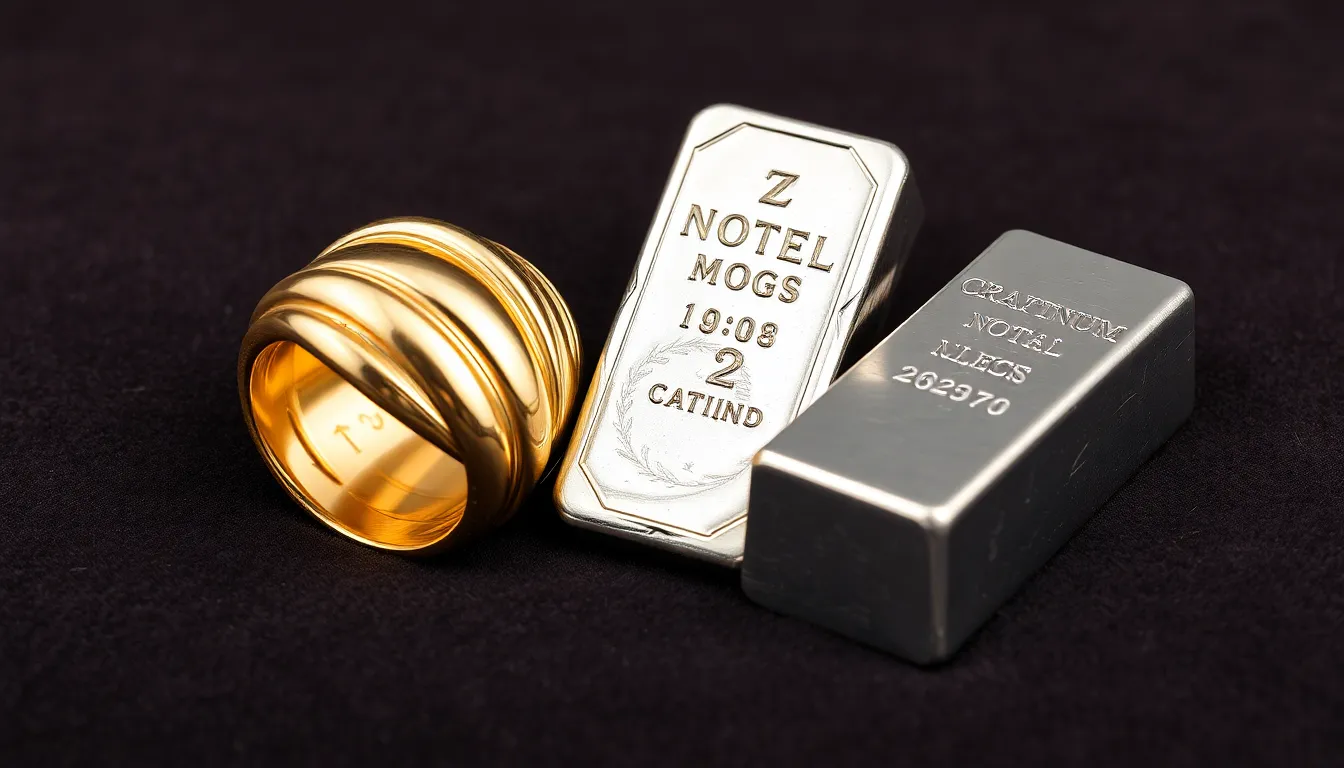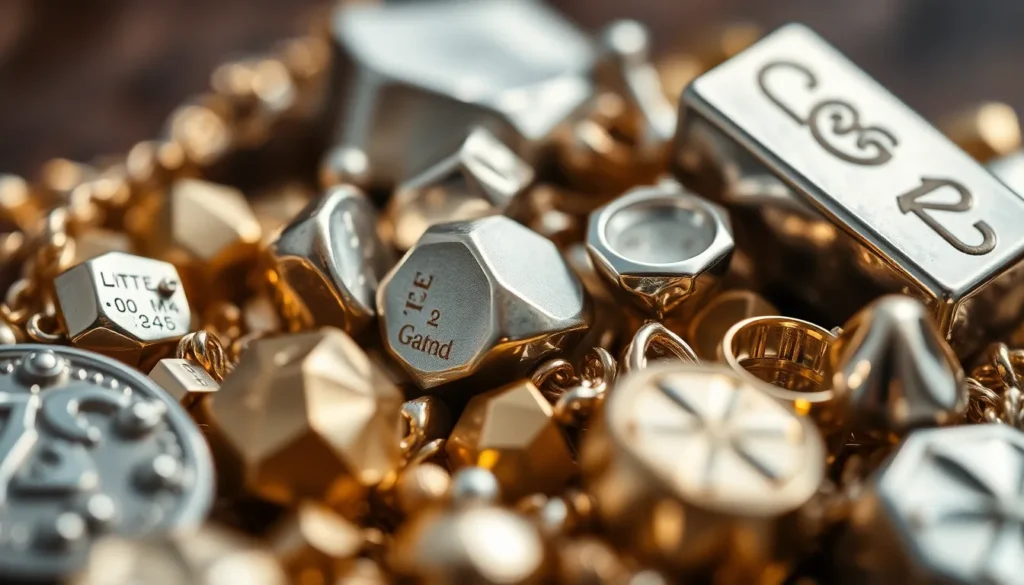Table of Contents
ToggleWhen it comes to metals, not all are created equal. Some shine brighter, resist tarnish, and flaunt their worth like they own the place. Enter the noble metals, the elite squad of the periodic table that refuse to play by the rules of oxidation. These precious elements are the gold stars of the metal world, boasting an impressive combination of beauty and durability.
But what exactly qualifies a metal for this prestigious title? It’s not just about looking good in jewelry or being the life of the party at the local scrap yard. Noble metals stand out for their remarkable resistance to corrosion and oxidation, making them the go-to choice for everything from high-end electronics to fine art. Let’s dive into the glittering realm of noble metals and discover which elements have earned their spot on the VIP list.
Overview of Noble Metals
Noble metals include gold, silver, platinum, palladium, rhodium, ruthenium, and iridium. These metals exhibit notable resistance to oxidation and corrosion, which contributes to their long-lasting nature. Gold remains a prime example, often utilized in jewelry and electronics due to its non-reactivity.
Silver finds applications in photography and medical devices, thanks to its antibacterial properties. Platinum plays a crucial role in catalytic converters, reducing harmful emissions in vehicles. Palladium’s unique ability to absorb hydrogen makes it valuable for catalytic reactions in various industries.
Rhodium often features in automotive applications and jewelry, prized for its bright finish and durability. Ruthenium is typically employed in electronics, serving as a key material for resistors and capacitors. Iridium, the most corrosion-resistant metal, finds use in high-temperature applications, including spark plugs and specialized equipment.
These noble metals possess significant economic value, trading at high prices due to their scarcity and industrial importance. Their applications span multiple sectors, including technology, healthcare, and finance. Understanding noble metals and their properties aids in recognizing their role in modern society.
Common Noble Metals

Noble metals possess unique properties, making them highly sought after in various industries. Key examples include gold, silver, and platinum, each valued for distinct characteristics and applications.
Gold
Gold stands as a well-known noble metal, prized for its striking appearance and exceptional resistance to tarnish. It remains a popular choice for jewelry and luxury items due to its malleability and aesthetic appeal. In electronics, gold establishes crucial connections because it doesn’t oxidize or corrode, enhancing reliability in devices. The finance sector also utilizes gold as a standard for wealth, impacting global markets. Its scarcity and universal acceptance contribute to gold’s high value, making it a stable investment option.
Silver
Silver, another prominent noble metal, showcases excellent conductivity, distinguishing it in electrical applications. The metal possesses inherent antibacterial properties, which are beneficial in medical devices and instruments. In photography, silver halides play a significant role in film production, emphasizing its versatility. Jewelry-making also frequently employs silver due to its luster and affordability compared to gold. The fluctuating market prices influence silver’s investment potential, attracting both collectors and industrial users.
Platinum
Platinum ranks highly among noble metals for its durability and resistance to oxidation. Frequently found in automotive catalytic converters, it significantly reduces harmful emissions from vehicles. The unique density and weight of platinum enhance its use in fine jewelry, often favored for engagement and wedding bands. Financial markets consider platinum a valuable asset, although it generally costs more than gold and silver. Its limited availability combined with diverse industrial demands solidifies platinum’s status as a highly prized noble metal.
Rare Noble Metals
Palladium, a silver-white metal, plays a crucial role in many industrial applications. It’s extensively used in automotive catalytic converters to reduce harmful emissions. Additionally, palladium’s properties make it suitable for electronics and dentistry. This metal also boasts exceptional resistance to oxidation and corrosion, enhancing its longevity in various environments.
Iridium stands out as one of the most corrosion-resistant metals known. Its density and durability make it invaluable for high-temperature applications, such as spark plugs and specialized electrical contacts. Many watchmakers also utilize iridium for its scratch resistance, ensuring longevity in timepieces. The metal’s high melting point adds to its appeal in environments where other metals might fail.
Osmium, known for its unique blue tint, is the densest naturally occurring element. This metal finds its application primarily in the production of fountain pen nibs, electrical contacts, and other specialized equipment. Due to its rarity, osmium holds significant economic value. Its properties include high durability and resistance to wear, making it ideal for precision instruments. Over time, osmium’s unique characteristics have drawn interest for potential applications in various technologies.
Characteristics of Noble Metals
Noble metals exhibit distinct characteristics that contribute to their unique applications and value. These attributes primarily include corrosion resistance and conductivity.
Corrosion Resistance
Corrosion resistance defines noble metals, allowing them to maintain integrity in aggressive environments. Gold remains unaffected by moisture, air, and various chemicals. Silver, while less resistant, develops a protective layer of silver sulfide that mitigates further degradation. Platinum demonstrates remarkable resilience against oxidation and corrosion, making it essential for industrial applications. Palladium’s properties also include substantial resistance, particularly in catalytic converters. Rhodium ranks high in corrosion resistance and is often used to enhance durability in automotive applications. Elements like iridium and ruthenium provide unparalleled resistance, securing their vital roles in high-stress environments.
Conductivity
Conductivity among noble metals varies, contributing to their usage in electronic applications. Silver ranks as the best conductor of electricity, surpassing all other metals. This exceptional conductivity allows silver to excel in electronic devices and medical equipment. Gold follows closely, offering reliable conductivity alongside resistance to tarnish, making it ideal for connectors and circuit boards. Platinum, while not as conductive as silver or gold, still possesses useful conductive properties that benefit various technologies. Palladium’s conductivity is also noteworthy, enhancing its role in electronics and catalysis. Rhodium’s electrical conductivity, while less prominent, further supports its application in connectors.
Applications of Noble Metals
Noble metals find extensive applications across various domains due to their unique properties. Their resistance to corrosion enhances longevity and maintains performance.
Jewelry and Ornaments
Gold and silver dominate the jewelry industry. Gold’s non-reactive nature ensures its beauty lasts for generations, making it a favorite for engagement rings and necklaces. Silver, with its brilliant luster, offers affordable options for decorative items and everyday wear. Platinum’s rarity and durability elevate its status in high-end jewelry. Various pieces often combine these metals for aesthetic appeal and functionality, attracting consumers who prioritize quality and style.
Industrial Uses
Noble metals serve crucial functions in industrial applications. Platinum significantly reduces harmful emissions in vehicles via catalytic converters. Palladium excels in fine-tuning catalytic reactions, impacting energy efficiency across sectors. Silver’s exceptional conductivity makes it vital in electronics, enhancing circuit design and performance. Ruthenium contributes to the development of specialized resistors and capacitors found in cutting-edge technologies. Each metal’s unique attributes facilitate advancements in various industries, showcasing their importance in modern society.
Noble metals play a crucial role in various industries due to their unique properties. Their resistance to corrosion and oxidation not only enhances their durability but also makes them highly sought after in applications ranging from electronics to jewelry. Each noble metal brings its distinct advantages to the table, whether it’s gold’s non-reactivity or platinum’s effectiveness in reducing emissions.
As technology continues to advance, the significance of noble metals will likely grow even further. Their economic value and versatility ensure they remain integral to modern society, underscoring the importance of understanding these elite materials.







